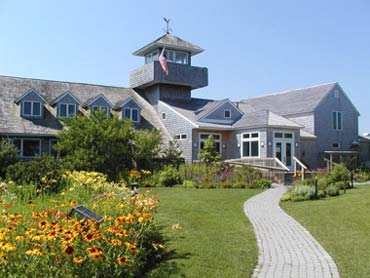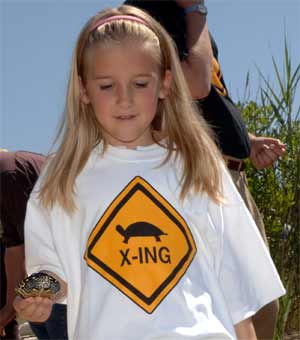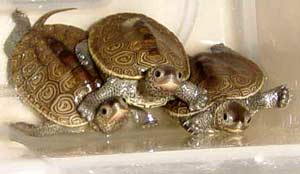 |

The Wetlands Institute is a private, non-profit organization located on salt marshes of the Cape May Peninsula in southernmost New Jersey. Its mission is to promote appreciation of the vital role wetland and coastal ecosystems play in the survival of life on this planet. Since its founding in 1969, the Wetlands Institute has routinely involved undergraduate students in a wide variety of research projects pertaining to coastal environments and the organisms inhabiting them. The focus of the research is Conservation Biology. See the Coastal Conservation Research Program (CCRP). To see more of the activities of the CCRP, visit its Facebook page.

Since 1989, the Wetlands Institute, in cooperation with The Richard Stockton College of New Jersey, has conducted a diamondback terrapin conservation project. Each summer, college and university students come from all over the United States to assist these creatures that are so desperately in need of our help. International Student Researchers from Asia began joining the program in the year 2000. All of these researchers are joined in their efforts by a small group of dedicated local volunteers.

For well over a century, diamondback terrapins, the only species adapted to life in the brackish waters of coastal salt marshes, have been adversely affected by a variety of human activities. A century ago, overhunting of the northern diamondback terrapin, Malaclemys terrapin terrapin — considered a gourmet delicacy — nearly extirpated populations in many parts of its range. Eventually, the combined effects of Prohibition (sherry was considered an essential ingredient of terrapin stew recipes) and the economic stresses of the Great Depression in the 1930s brought an end to significant commercial exploitation of terrapins. It was not until nearly the late 1960s that terrapin populations
 |
 |
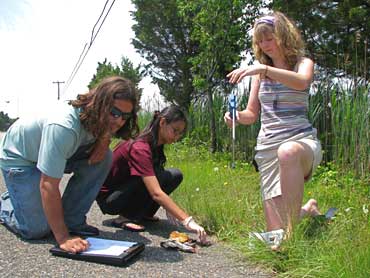

2008 student researchers (from right to left) Jon Roth, Ursinus College; Pelf Chen, Asian Scholar from Malaysia; and Liz Dancer, Delaware Valley College, record data from road-killed terrapin. |
|
recovered to a level approaching their former “pre-gourmet” abundance. More recently, however, two other threats to terrapin populations have arisen. Coastal development has led to considerable habitat destruction, especially of traditional nesting sites on barrier beach islands. Along the Atlantic coast of New Jersey, the search for alternative nesting sites on highway embankments has resulted in large numbers of roadkills every nesting season. And the loss of terrapins to the commercial crabbing industry, through drowning in crab traps, has increased dramatically.

The serious declines in southern New Jersey’s terrapin population, due to increased mortality from roadkills and drowning in crab traps, prompted the launching of the Terrapin Recovery/Conservation Project in 1989. Under the direction of Dr. Roger Wood, the program has developed techniques to incubate and hatch eggs recovered from road-killed terrapins, after which the hatchlings are head started and released. In addition, the program’s ongoing studies have proven the effectiveness of terrapin excluder devices to prevent drowning in crab traps.

Research interns will work closely with Dr. Wood and the Wetlands staff to receive a practical laboratory and field course in hands-on conservation. This will include round-the-clock road patrols during the terrapin nesting season in June and July, to minimize the number of roadkills of nesting females, as well as the removal of potentially viable eggs from the carcasses of roadkills. Eggs are incubated and, after hatching, head-started at the Richard Stockton College “turtle farm.” Head-started turtles (hatched from the previous season) are weighed, measured, marked (with a microchip PIT tag injected just beneath the skin in front of the rear leg), and released into the salt marsh. For more information see Terrapins and Tires.

Commercial crab traps are widely used throughout the range of diamondback terrapins. Experiments on the Cape May Peninsula in southernmost New Jersey and elsewhere show that crab traps catch significant numbers of terrapins of both sexes, including both juveniles and adults. Unfortunately, substantial proportions of these terrapins drown before the traps are pulled for the daily crab harvest. In fact, incidental capture and drowning in commercial crab traps is the number one killer of diamondback terrapins in New Jersey, with deaths estimated at 14,000–15,000 per year in the mid-1990s. It is likely that considerably larger numbers of terrapins are killed throughout this species’ entire Atlantic and Gulf coast range every year.
Many of these deaths can specifically be attributed to ghost crab traps, which are derelict traps that have been lost or abandoned and are no longer being checked and emptied of their catches. It is estimated that 2 million crab traps are commercially and recreationally used annually, with approximately 25 percent of those traps becoming lost or abandoned. In the summer of 2000 a student researcher removed 32 ghost traps from the vicinity of the Wetlands Institute, many of which contained dead terrapins; one contained at least 15. In 2007, over a 13-day period, a student researcher located and removed 41 ghost traps from the salt march creeks and sounds. The ghost traps contained at least 41 dead terrapins and various other marine organisms, including 37 blue crabs. Only four of the 41 ghost traps were equipped with Terrapin Excluders Devices (TEDs), which are designed to reduce bycatch of terrapins. This source of terrapin mortality could be greatly reduced if regulations to prevent bycatch were strengthened. Terrapins and other marine animals would also benefit from the organization of large community trap removal efforts.


 |
 |
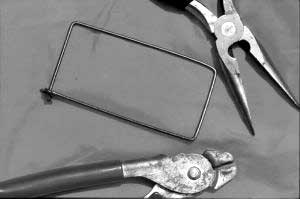

A simple rectangular wire frame, fitted to
the opening of crab trap, serves as
an effective terrapin excluder. |
|
Considerable effort has also been devoted to the development and testing of the terrapin excluders for commercial crab traps. In 1992 a rectangular wire excluder device was developed to fit into the inner (narrow) end of entrance funnels in a typical commercial crab trap. This device was designed to prohibit the entry of most terrapins yet not impair the number or size of crabs caught. Results from the program’s long-term studies have been very positive: not only have the excluders greatly reduced the number of terrapins caught in modified traps, they have also actually increased the crab catch over unmodified traps of standard design. Three states (New Jersey, Maryland and Delaware) have adopted regulations mandating the use of terrapin excluders under certain circumstances. For more information see Terrapins and Traps.

Increased motor vehicle traffic on the causeways between the mainland and the barrier islands of coastal southern New Jersey is a growing threat to diamondback terrapins. Development on the barrier islands has destroyed most of the sand dunes that originally served as the primary nesting site for terrapins. With the disappearance of sand dunes,
 |
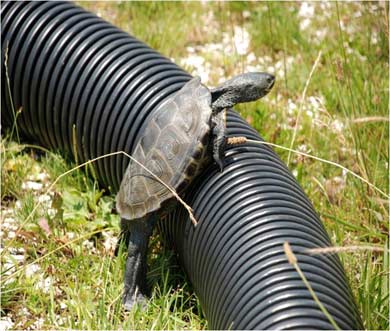

Corrugated drainage pipe is now installed by the Wetlands Institute as barrier fencing to reduce nesting terrapin roadkills. A terrapin is shown attempting to climb the tubing but is unsucessful.
|
|
 |
females have had to find alternative nesting grounds, primarily the shoulders of roads crossing and adjacent to their native salt marshes. Embankments of causeways have proved to be a dangerous substitute for sand dunes, resulting in hundreds of terrapin roadkills annually.
In 2004 researchers from the Wetlands Institute began to install temporary silt fencing along the coastal causeways, in an attempt to reduce road mortality of nesting terrapins in areas known to be major “kill zones.” For three summers, the fencing along Stone Harbor Boulevard reduced terrapin mortality, on average, approximately 84 percent. In 2006, in an attempt to improve the fencing project, a 1,000-foot section of a new fencing material, “Tenax” (a thick, mesh material), was installed to determine its durability in the harsh coastal conditions over the course of a year. The Tenax proved to be durable, so in 2007 the Wetlands Institute installed the year-round Tenax fence along the entire section of Stone Harbor Boulevard. In addition, the fencing project was expanded to include a mile and a half section of Avalon Boulevard (using a combination of both Tenax and silt fence material), which, because the fence was installed in a continuous line with no openings, resulted in a 100 percent reduction of terrapin roadkills.
By 2009 the Tenax fencing, susceptable to snow damage from plowing and damage from weed whackers, was also showing signs of deterioration. Six-inch corrugated plastic drainage pipe was proven experimentally to be an effective barrier, and in June 2010 over 7,000 feet of corrugated tubing was installed along the Margate Causeway. It proved much quicker and easier to install than either silt or Tenax net fencing. See A Guide for Building Terrapin Barriers and Fences.

 |
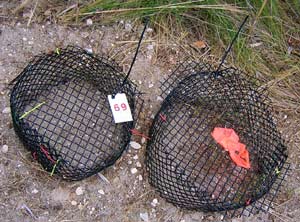

Two predator exclosures constructed
around terrapin nests
|
|
From the end of May to late July, female terrapins emerge from the marsh to nest on high ground, digging a 6–8 inch hole and laying approximately 8–12 eggs. Numerous terrapin nests are preyed upon each summer, particularly along the Wetlands Institute’s nature trail. To help reduce this loss, we construct predator exclosures (black mesh cages) over the nests to protect the eggs from various predators such as raccoons, skunks, and foxes. In 2008 we constructed 50 predator exclosures along the nature trail. To locate terrapin nests, student researchers regularly walk the vicinity of the Wetland Institute and the nature trail, searching for nesting terrapins. When they come across a terrapin, they wait patiently until the nest is completed. A predator exclosure is then constructed over the nest, and the turtle is retrieved to be microchipped for future identification. In 50–90 days terrapin hatchlings emerge from the nests. In the fall and in the spring (as some hatchlings overwinter in the nest), Wetlands Institute staff monitor the predator exclosures several times a day to remove emerged hatchlings and record measurement data. We release the hatchlings at night so they don’t become instant gull food!


In 2005, the Wetlands Institute’s began conducting a sonic telemetry study, attaching small coded transmitters to adult diamondback terrapins. The transmitter sends a unique signal through the water to a receiver that is attached to a buoy located in the marsh. Each time a terrapin swims by an underwater acoustic receiver, information is recorded. We then use the information collected by the receiver to determine where a terrapin is, how far it moves, and how long it takes to move from one location to another. This information is extremely valuable because little is known about terrapin movements (particularly because females leave the water only during the nesting season and males barely ever leave the water other than to bask in the sun).



Adult female terrapin with attached coded transmitter
|
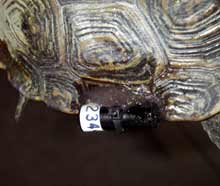

Closeup of transmitter attached
to edge of terrapin’s shell
|
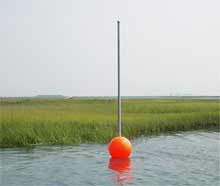

Underwater acoustic receiver detects terrapins with transmitters.
|
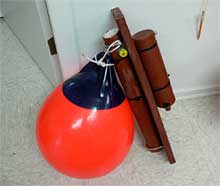

Close-up of equipment showing
detail of submerged receiver |
|

Currently, we have 9 receivers strategically placed throughout the marsh, specifically near the mouths of creek openings. Over the past four years, 65 terrapins have been fitted with mobile transmitters (Vemco V9-2L-R04K coded pingers), attached to the margins of their shell and then released back into the salt marsh. Results so far show that there is considerable individual variation in the movements of different terrapins.

|
 |
![]()
![]()
![]()
![]()
![]()
![]()
